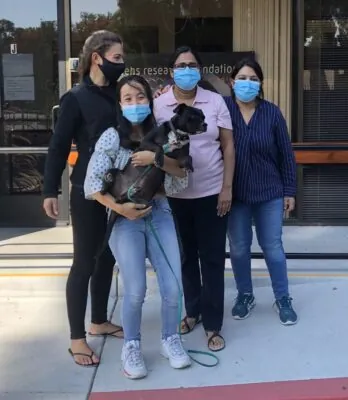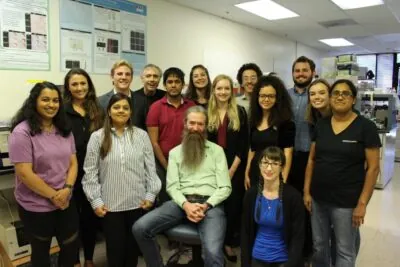Boominathan Lab
Working to understand mitochondrial biology and developing gene therapies to address mitochondrial dysfunction and aging.
Photo by Erin Ashford
Boominathan Lab Lab Focus
The efforts of Dr. Boominathan’s lab are dedicated towards identifying translational avenues to combat mitochondrial dysfunction, a major cause of aging and age-related diseases, by focusing on the repair or replacement of damaged mitochondrial DNA and the maintenance of mitochondrial health.
Her lab aims to:
- Preserve and maintain mitochondrial function in cells, as mitochondria are essential for energy production and cellular health.
- Develop gene therapy approaches, such as allotopic expression, to relocate essential mitochondrial genes to the nucleus, thereby protecting them from mutation and dysfunction.
- Create innovative solutions (including gene drives and mitochondrial transplantation) to correct or bypass mitochondrial DNA mutations that cause disease.
- Translate basic research into tangible therapies for mitochondrial disorders and age-related decline, with a focus on improving human healthspan and lifespan.
Active Projects
Advancing Mitochondrial Health with Protective Gene Copies
Research Info
Mitochondria perform and support several vital functions in a cell, and the alternate genome, mtDNA, plays a critical role in organelle maintenance. There is increasing evidence that mitochondrial function declines with age, and that dysfunctional mitochondria adversely contribute to several metabolic and neuromuscular diseases. Our goal is to address age-acquired and inborn errors of mutation in the mtDNA using a gene therapy approach. We are exploring:
allotopic expression (expressing mtDNA genes from the nucleus), and
whole-organelle replacement
as strategies to revitalize mitochondrial function. Our multidisciplinary approach employs cell culture and mouse models to achieve our objectives.
Allotopic Expression of Proteins Encoded in the Mitochondrial DNA
Mitochondria are the ‘power plants’ in every mammalian cell responsible for the efficient conversion of nutrients to energy. Impaired mitochondrial function and mutations in mtDNA contribute to several age-related illnesses, including Alzheimer’s Disease, Parkinson’s disease, and sarcopenia. Point mutations in any of the 13 protein-coding regions, as well as micro- and macro- deletions in the mtDNA, lead to several monogenic and organelle-specific diseases (MELAS, MEERF, LHON, Leigh’s disease to name a few). However, alterations in the OriH / OriL regions in the mtDNA can lead to global impairment in the transcription and translation of the mitochondrial genome. The mitochondrial proteome, however, consists of ~1400 proteins of which all except for the 13 polypeptides translated on the mitochondrial genome originate from the host’ nucleus. Over the course of evolution, mitochondria have developed sophisticated mechanisms to import these nuclear mitochondrial proteins. These mechanisms employ intricate translocases and signals, which are directed to different regions within the organelle.
The goal of this project is to determine how we might achieve optimal parameters for coding and non-coding regions to efficiently express and target the 13 mtDNA genes to the respiratory chain from the nucleus. Toward this end, we employ molecular biology, biochemistry and computational strategies, and refine and build on our existing knowledge of import conditions for the numerous nuclear mitochondrial proteins already delineated. We use patient-derived cybrids and animal models in assessing the functional utility of our constructs. Ultimately, we aim to express the mtDNA genes individually or in combination to overcome age-related changes to the mtDNA and improve overall organelle fitness. Please see here for recent progress on this project.
Reversing Age-Induced Mitochondrial Damage through Organelle Transplantation
Intercellular mitochondria exchange occurs naturally in the human body between cell types, typically between healthy and damaged cells. Three different transfer mechanisms have been observed:
stem cells release naked mitochondria that are taken up by other cells,
mitochondria are released extracellularly, enclosed in vesicles that are in turn taken up by recipient cells (possibly via endocytosis), or
mitochondria migrate from one cell to another through specialized structures in vivo, such as nanotubes.
The goal of this project is to evaluate the potential of mitochondrial transfer to counteract age-related loss of tissue function. We aim to develop strategies to purify viable mitochondria and deliver them to target regions in the body.
Budget
Annual Budget
285,000 USD
Mitochondrial Makeover: Replacing Old Power Sources with New
The Problem
Aging creates an accumulation of mutations in the DNA of our mitochondria, the organelles that create our energy supply on a molecular level. This impacts and impairs their ability to function correctly and creates a myriad of energy issues as we age.
The Goal
The team is creating a drive to implant new genes more aggressively, like a sped-up evolutionary track, through mitochondria that have been engineered with an enzyme capable of destroying all current mitochondrial DNA in a cell. These new mitochondria will replace all the mutated and aged mitochondria with healthy, functional mitochondria entirely
The Status
The first hurdle was overcome when the team developed a way to keep new mitochondria within the cells – which had never been previously accomplished. They are working to optimize the percentage of surviving mitochondria before fully engineering the more aggressive strains for injection.
A Gene Drive Strategy for Mitochondrial Mutations
The Boominathan lab is in the preliminary stages of developing a gene drive solution to mitochondrial mutations. Gene drives are a biotechnology that mimics naturally-occurring genetic elements that enhance their own propagation through a population at the expense of other genes in the genome, independently of natural selection mechanisms. The strategy is to engineer mitochondria with wild-type genomes except for a restriction enzyme that would cleave restriction sites in native mitochondrial genomes, destroying them and replacing them over the course of cycles of mitochondrial fusion and fission.
The targeted restriction site would be engineered out of therapeutic mitochondria to allow them to escape its effects. This would leave the cell with fully functional mitochondria without reference to the initial state of the cell’s mitochondrial genomes. The approach would be repeatable by alternating the targeted restriction site for each round of treatment.
The initial benchmark achieved is the incorporation of mitochondria into cells in culture persisting for extended periods. Previous reports in vitro and in vivo mitochondrial transplantation have found that the transplanted mitochondria are only detectable for periods less than two weeks. The Boominathan lab’s new protocol enables small numbers of transplanted mitochondria to persist for months, but even very few persistent gene drive-enabled mitochondria would be sufficient to progressively repopulate the host cells.
Budget
Annual Budget
220,000 USD
Restoring Cell Energy by Stopping the Spread of Damaged Mitochondria
The Problem
Aging creates an accumulation of mutations in the DNA of our mitochondria, the organelles that create our energy supply on a molecular level. This impacts and impairs their ability to function correctly and creates a myriad of energy issues as we age. The most prevalent and dangerous types of mutations are the large deletions of DNA – which completely take over the cell and outcompete healthy mitochondria through a mechanism that hides them in plain sight.
The Goal
To prevent cells from being overrun by highly mutated mitochondria, the mechanism that cloaks them from detection and removal needs to be found and countered.
The Status
A mechanism has been found for this ability of the mutated mitochondria to hide and spread and a class of drugs has been identified to inhibit it. The most promising drug improves the removal of mutated mitochondria seemingly by targeting specifically the deletion mutation that is most prevalent.
Restoring Mitophagy Surveillance to mtDNA Deletion-Bearing Mitochondria
The most prevalent mitochondrial mutations in aging cells — and the ones most closely linked to diseases of aging — are large deletions in the genome. A surprising feature of these mutations is that in cells where they occur, mitochondria bearing large deletions are homoplasmic within the cell, pointing to clonal expansion having outcompeted both healthy mitochondrial genomes and mitochondria bearing only minor mutations in one or a few specific mitochondrial genes. The best-supported mechanistic explanation for this finding is that deletion-bearing mutations escape surveillance by the mitophagy machinery, likely due to the absence of signals that are closely linked to the operation of the respiratory machinery that would otherwise attract key components of the mitophagy machinery. This project aims to use small molecules to inhibit a target that allows deletion-bearing mitochondria to survive without attracting these mitophagy components, thus eliminating the selection advantage underlying their clonal expansion.
Promisingly, one of three candidates elicited a substantial shift in favor of wild-type mitochondrial genomes in a cell line heteroplasmic for the common age-related deletion, while only causing a minor favorable shift in heteroplasmy in a point mutation cybrid line. This differential effect is consistent with the mitophagy-avoidance mechanism that has been hypothesized to underlie large deletion mutations’ clonal expansion. The Boominathan lab is now conducting additional studies to confirm the mechanism and to identify or develop drug variants with improved biochemical efficacy.
The goal of this project is to determine how we might achieve optimal parameters for coding and non-coding regions to efficiently express and target the 13 mtDNA genes to the respiratory chain from the nucleus. Toward this end, we employ molecular biology, biochemistry and computational strategies, and refine and build on our existing knowledge of import conditions for the numerous nuclear mitochondrial proteins already delineated. We use patient-derived cybrids and animal models in assessing the functional utility of our constructs. Ultimately, we aim to express the mtDNA genes individually or in combination to overcome age-related changes to the mtDNA and improve overall organelle fitness. Please see here for recent progress on this project.
Budget
Annual Budget
345,000 USD
Completed Projects
Creation of Novel Mouse Lines to Test New Mitochondria Therapies
The Problem
Aging creates an accumulation of mutations in the DNA of our mitochondria, the organelles that create our energy supply on a molecular level. This impacts and impairs their ability to function correctly and creates a myriad of energy issues as we age. Testing potential therapies for use in humans requires a robust testing model that hasn’t yet been developed.
The Goal
Building upon prior LRI programs, the team is engineering mice that have specific mutations in their mitochondrial DNA, for testing purposes. They grow normally but show the defects common in humans with the same types of mutations.
The Status
Mouse models have been established for two of the thirteen mitochondrial genes successfully. This has led to functional testing of possible therapeutics in other Boominathan lab projects. More models are needed to continue developing further therapeutics for humans.
Allotopic Expression In Vivo
Mitochondrial mutations drive aging phenotypes and specific diseases of aging. The Boominathan lab has made substantial progress in the allotopic expression (AE) of mitochondrial genes from the nucleus as a mitochondrial gene therapy solution for this problem with their greatest success to date being the successful rescue of a patient cybrid cell line with a severe ATP8 mutation via AE ATP8 and ATP6. To implement AE as a therapeutic in aging people or as a treatment for congenital mitochondrial genetic diseases will require gene therapy. Gene therapy strategies utilizing viral vectors such as adeno- or lentiviruses are limiting in their cargo sizes and risk disrupting neighboring genes during random integration. To overcome the limits of these and other gene therapies, we have developed a mouse model in which the docking site for a phage integrase has been engineered into a well-characterized safe harbor locus in the mouse nuclear genome.
Using these mice, the Boominathan lab generated two transgenic mouse models expressing the AE ATP8 gene from this safe harbor locus. One line of such mice has wild-type mouse mitochondrial ATP8 genes, while the other has a mitochondrial ATP8 polymorphism (FVB) that has been reported to cause mild biochemical perturbations. This allowed for the assessment of both the potential of AE ATP8 to rescue the FVB polymorphism, and the risk that it might disrupt the normal functioning of the wild-type ATP8. Additional mouse lines are needed to continue testing in vivo the therapies generated by the Boominathan lab, and other mitochondria labs globally.
Team Members
Principal Investigator

Amutha Boominathan, PhD
Research Staff
Please visit the Work With Us page to learn about available positions.

Kathlene Joyce, PhD (Staff Scientist I)

Bhavna Dixit, MS (Senior Research Associate)

Jonathan Ayache, BS (Research Technician)
Graduate Interns

Juan Pablo Sofia Partarrieu
Postbaccalaureate Fellow

Nitya Jain
Summer Scholars

Audrey Tsai
High School Interns

Chaitra Vengalam
Lab Alumni
Research Staff
- Jayanthi Vengalam (2012-2015) – now at Protagonist Therapeutics
- Shon Vanhoozer (2014-2017)
- Kathleen Powers (2015-2017) – now at Bristol Myers Squibb
- Caitlin Lewis (2017-2021) – now at LEV Foundation
- Carly Troung (2021-2022) – now at Alkahest
Summer Scholars and Postbaccalaureate Fellows
- Ali Crampton (Summer Scholar, 2012; Summer Scholar, 2013) – continued to Graduate School, University of Minnesota
- Summer Wang (Summer Scholar, 2014) – continued to Graduate School, Columbia University
- Natalie Friedricks (Summer Scholar, 2015) – continued to Medical School, University of Southern California
- Elizabeth Batiuk (Summer Scholar, 2016) – continued to Medical School, University of Portland
- Jasmine Zhao (Summer Scholar, 2017) – continued to Medical School, University of Southern California
- Michaela Copp (Summer Scholar, 2017) – continued to Graduate School, University of North Carolina
- Martina Velichkovska (Summer Scholar, 2018) – continued to Graduate School, University of California, Berkeley
- Carter Hall (Postbaccalaureate Fellow, 2018-2019) – continued to MS Health Administration, University of Alabama
- Sanjana Saravanan (Summer Scholar, 2019; Postbaccalaureate Fellow, 2019-2020) – continued to research at Stanford University
- Nana Anti (Postbaccalaureate Fellow, 2019-2020) – continued to Medical School, Loma Linda University
- Aly Ung (Summer Scholar, 2020)
- Carly Truong (Postbaccalaureate Fellow, 2020-2021)
- Lauren Kirk (Postbaccalaureate Fellow, 2020-2021) – continued to research at University of Pennsylvania
- Nathan Schaumburger (Postbac Fellow, 2021-2022) continued to graduate studies at Harvard University
- Simon Garey (Postbaccalaureate Fellow, 2023-2024)- continued to Industry
- Allen Trevizo (Postbaccalaureate Fellow, 2024)
Publications
- Begelman DV, Dixit B, Truong C, King CD, Watson MA, Schilling B, Brand MD, Boominathan A Exogenous expression of ATP8, a mitochondrial encoded protein, from the nucleus in vivo Mol Ther Methods Clin Dev. 2024 Nov 6;32(4):101372. doi: 10.1016/j.omtm.2024.101372. eCollection 2024 Dec 12.PMID: 39659757.
- Saravanan S, Lewis CJ, Dixit B, O’Connor MS, Stolzing A, Boominathan A. The Mitochondrial Genome in Aging and Disease and the Future of Mitochondrial Therapeutics. Biomedicines. 2022 Feb 18;10(2):490. doi: 10.3390/biomedicines10020490.PMID: 35203698.
- Dixit B, Vanhoozer S, Anti NA, O’Connor M S, Boominathan A. Rapid enrichment of mitochondria from mammalian cell cultures using digitonin. 2021 MethodsX, 8. https://doi.org/10.1016/j.mex.2020.101197
- Lewis CJ, Dixit B, Batiuk E, Hall CJ, O’Connor MS, Boominathan A. Codon optimization is an essential parameter for the efficient allotopic expression of mtDNA genes. Redox Biol. 2020 Feb;30:101429. doi: 10.1016/j.redox.2020.101429. Epub 2020 Jan 11. PMID: 31981894; PMCID: PMC6976934.
- Boominathan A, Vanhoozer S, Basisty N, Powers K, Crampton AL, Wang X, Friedricks N, Schilling B, Brand MD, O’Connor MS. Stable nuclear expression of ATP8 and ATP6 genes rescues a mtDNA Complex V null mutant. Nucleic Acids Res. 2016 Nov 2;44(19):9342-9357. doi: 10.1093/nar/gkw756. Epub 2016 Sep 4. PMID: 27596602; PMCID: PMC5100594.
Photos
Funding
To support our work please consider making a donation to Lifespan Research Institute!
Thanks to our existing funders:
Lifespan.io Crowdfunding Campaigns
Research breakthroughs into the core mechanisms of aging are critical to extending healthy human lifespan and building momentum for the field in general, and you can make a key difference. Join us in driving progress toward longer, healthier lives.
Donate to Lifespan Research Foundation
Please enter the amount you wish to give, and click "Donate".
Recurring Donation Subscription
Please enter the amount you wish to give, and click "Donate".









